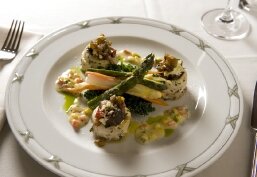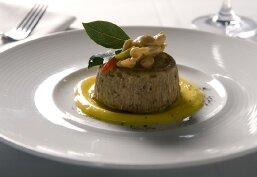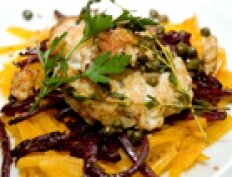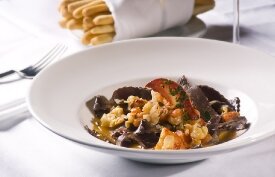





Most businesses have a few obstacles to overcome when they first start out. In Valentino’s case, it was mountains. Opened in a former dive bar next to an auto shop and a red-light motel, the place was to be run by two partners with limited experience on a shoestring budget. While they excelled at making their customers feel at home, their cuisine, wine list, and décor left much to be desired. This, however, did not discourage them. With a little luck and a lot of hard work, the restaurant grew, evolved, and eventually matured into one of America’s best Italian restaurants, complete with an award-winning wine cellar.
Whether it is fate, dedication, or just one of the most amazing examples of the American dream come true, Valentino remains one of the most beloved restaurants, despite disagreeing partners, earthquakes, recessions, and competition. Almost thirty-five years and counting.
The restaurant’s humble beginning started with a partnership between two friends, each providing an investment of $5,000. Gianni Paoletti, a chef, and Piero Selvaggio, an
Italian immigrant and recent college graduate with a couple of years of front-of-the-house experience under his belt, dreamt of opening a restaurant that would spark their careers in the business. Undeterred by the small amount of capital they possessed, they found their restaurant location – a run-down beer bar on a less than desirable street in eastern Santa Monica. “This was all we could afford. So we rented it,” states Piero.
What they lacked in funds they made up for with enthusiasm and determination, scrubbing floors and painting walls themselves to prepare for the grand opening. Piero wrote a menu inspired by his mother’s simple, traditional Italian cooking of his youth and the American interpretation of Italian food he had experienced after moving to the States. “We didn’t know much about food, so we served what we knew. Hearty sauces, American dishes with Italian names like Baked Mostaccioli. A lot of it was pre-cook for convenience.”
The final task was finding the right name. They brainstormed and eventually came up with Valentino. “It reminded us of Rudolph Valentino,” recalls Piero, “which we associated with glamour and sophistication and, of course, he was Italian. It was perfect.”
On December 4, 1972, Valentino opened for business. The restaurant got off to a painstakingly slow start, worrying the partners greatly, but their luck changed drastically before the first month was over when The Los Angeles Times printed a rave review that described Valentino as a burgeoning restaurant jewel. Business picked up, and instead of serving a handful of patrons, they all of a sudden had a full house. The tiny restaurant with big hopes had made it over its first big hump.
For the next two years Valentino was the darling of the dining scene. “The restaurant was loud and always overbooked,” remembers Piero, “people just felt comfortable and enjoyed the food.” As the business grew, the partners started to entertain thoughts of expansion, but soon realized they didn’t see eye to eye in respect to the future. So two years after they opened, the two came to a crossroads. “I wanted to improve and expand the restaurant,” explains Piero, “Gianni wanted to take on partners and open a second location. We couldn’t do both, so we decided to end our partnership.” Piero bought Gianni’s portion of the restaurant and, at the age of 27, became the sole owner of Valentino.
And with that, in early 1975, began a new era. Free to improve as he pleased, Piero expanded the restaurant and then turned his focus to the food. Determined to learn more about authentic Italian cuisine, he traveled back to his homeland and enlisted the help of a friend, well-known Italian wine magazine editor Pino Khail, to show him the ropes. Their culinary journey began in Milan, where his tutor introduced him to the countless treasures of Italian cuisine, full of different flavors and textures. The eager student experienced the taste of truffles, savored Porcini mushrooms, and explored a variety of different carpaccios for the first time. “We visited chefs who showed me that Italian food can be savory and light at the same time. I also realized that many of the ingredients were not yet available in America,” says Piero who then and there decided that this was what he wanted for his restaurant. He returned with a newfound fervor, determined to make Valentino a true Italian eatery.
Back in Los Angeles, Piero pushed the restaurant into a new direction. He banned heavy sauces from the kitchen, started sourcing the best ingredients and stressed the minimal use of salt. He also began his search for a suitable chef from Italy, eventually finding him in Pino Pasqualato. Pino, a traditionally trained chef from Venice, helped usher in the era of fine dining when he joined Valentino in 1977, bringing a sense of classic Italian cooking to the kitchen. At the same time, the restaurant also started to import exciting new ingredients and artisanal products like fresh buffalo mozzarella, white truffles from Alba, prosciutto and Parmesan cheese that America hadn’t seen before. Slowly, as the changes were taking hold, Valentino evolved into a true Italian restaurant, one unlike anything else this country had ever seen.
Food, however, was not the only thing that mattered to the restaurateur; wine was equally important. A wine lover even before he opened Valentino, Piero now dedicated himself to learning more about the vintages of his home country and to improving his collection. Once again, he called on his friend Pino Khail to point him to the best sources.
He met Italy’s top vintners and made friends with local winemakers, learned about the soil and experienced regional differences for himself. A few weeks later Piero vowed to bring his enthusiasm for Italian wine to America – if necessary, one bottle at a time. And so a passion that eventually would make Valentino history was born.
He soon began stocking his wine cellar with some of the wines he had discovered while traveling. At a time when most Americans turned to the traditional stand-by France and the new rising star California for a good bottle, Piero sought out exceptional vintages from Italy that best represented the treasures held by Italian vineyards and introduced them. But he, too, took note of what was happening closer to home. “California was the new frontier of the wine world,” he explains, “and from the early days on, I supported the great small producers that made the wines that were the forefathers of today’s cult Cabs.”
As he traveled, tasted, observed, studied and collected, his cellar grew and slowly Valentino’s wine list became one of the most comprehensive in the industry, expanding from four to eight to forty and now to the famed one hundred-plus pages. In recognition of these efforts, Valentino won Wine Spectator’s highest honor, its Grand Award, in 1981, the first year the magazine’s awards were given. Since then, the restaurant has been honored every subsequent year, making Piero the only restaurateur who has been recognized for his wine list 24 years in a row – an honor he seems ready to replicate at Valentino Las Vegas, where he has also won the award every single year since the 1999 opening.
Once the complete package of good food, quality wine and gracious hospitality came together, the restaurant upped the ante: In 1986 chef Angelo Auriana took the helm at
Valentino and with him came a fresh culinary perspective. While Pino had focused on producing the best traditional fare, Angelo produced creative Italian-themed cuisine that embraced international ingredients, the best seasonal local produce and imported specialties from his homeland. Dishes like his House-made Tagliatelle with Duck Ragù, the Timballo of Fresh Porcini Mushrooms with a Saffron Fonduta, or the flavorful Rare Venison Chop with Juniper Berries showcased his ability to find inspiration globally and still maintain an Italian spirit. With the addition of Angelo, the restaurant now offered diners the best of both worlds, Old World classics as well as cutting-edge modern Italian cuisine. And over the next couple of years his Nuova Cucina won rave reviews and almost every conceivable award.
While the restaurant enjoyed much success, times were not without heartbreak. In 1994, the Northridge Earthquake hit Southern California, damaging businesses and homes alike. Valentino was no exception. “When I went to the restaurant, it was obvious that we had been hit hard,” Piero remembers. “In addition to the structural damage, I was greeted by a sea of red seeping out from under the door. My wine cellar had been devastated.”
30,000 precious bottles, valued well over a million dollars, were lost. The distraught owner, however, was not forgotten in this time of need. Many of the friends he made along the way, be it vintners, diners and fans of the restaurant, reached out. Winemaker friends sent special ‘Earthquake issue’ replacements for bottles that had perished. Patrons showed their support by returning to the restaurant even before the repairs were finished. The displays of compassion and generosity touched Piero: “It truly made me feel like Valentino is not just another restaurant, but an integral part of the community.”
Today, the Valentino wine cellar is once more an impressive collection and the restaurant continues to meet the needs and tastes of the diner. A major renovation is to be completed in August 2007 and will include V-vinbar – a unique wine tasting bar envisioned by Selvaggio, befitting the reputation of Valentino’s extensive collection. V-vinbar will have the allure required by a younger, curious audience that looks to for a quality experience in sleek, contemporary venues that invite a casual visit and do not require a special occasion or reservation to visit the restaurant.
With the classicism of the dining room and the contemporary style of V-vinbar, Valentino continues to reinvent itself. The restaurant is still, after 35 years, the ultimate destination in Los Angeles to experience authentic Italian cuisine – both formal and informal.